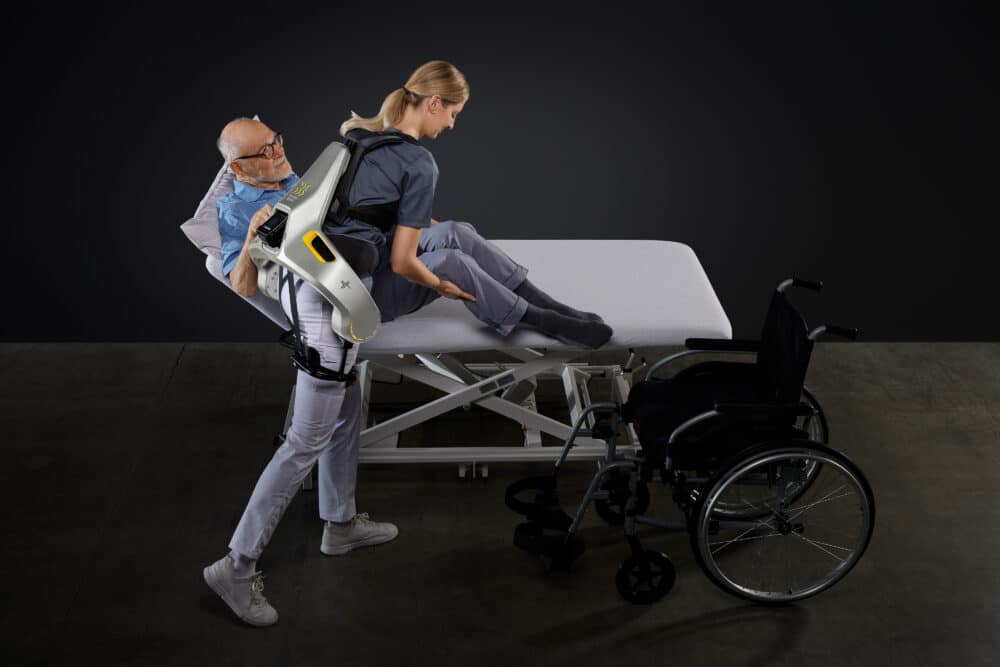The nursing industry is facing major challenges, including the shortage of skilled workers and the physical strain on nursing professionals. In this blog article, we will talk about the promising solution that exoskeletons represent in nursing. Exoskeletons for nursing professionals offer numerous benefits and could mean a revolution in the nursing industry.
Skilled nursing shortage: The care sector has been struggling with a significant shortage of skilled workers for years. The rising number of elderly people and the increasing demands on care are placing an excessive burden on existing staff. Exoskeletons could help close this gap by providing physical support to nursing professionals and increasing their performance. With an exoskeleton, caregivers can lift and transport heavy loads without endangering their own health.
Physical stress in nursing: Physical stress is an essential part of the nursing profession. Lifting and moving patients, negotiating obstacles and standing all day can lead to injury and chronic discomfort. Exoskeletons provide ergonomic support by reducing stress on muscles and joints. By properly aligning the spine and distributing weight, exoskeletons can relieve caregivers and improve their well-being.
More reasons for exoskeletons in nursing homes or care:
- Demographic change: The aging population is one of the main reasons for the shortage of skilled nursing staff. With the increase in life expectancy and the low birth rate, the number of older people in need of care is growing. This leads to an increased demand for care services, while at the same time fewer people are entering the care labor market.
- Strenuous working conditions: The nursing profession is physically and emotionally demanding. Nursing professionals often have to lift heavy loads, work overtime and do shift work. The high workload, combined with a lack of recognition and adequate pay, leads many potential nurses to decide against this profession.
- Insufficient training capacity: There are not enough training places and programs to meet the demand for qualified nurses. This leads to an imbalance between supply and demand in the nursing labor market. The limited number of training places also makes it difficult for potentially interested parties to gain access to nursing training.
- Low attractiveness of the profession: The nursing profession is often seen as unattractive because it is associated with stress, high responsibilities and low pay. Many young people therefore opt for other career paths that supposedly offer better working conditions and financial prospects.
- Migration of nursing professionals: Another factor contributing to the shortage of skilled workers is the migration of nursing professionals to countries with better working conditions and salaries. This leads to a brain drain in the nursing sector, further depleting existing resources.
How can exoskeletons help in care? Exoskeletons are wearable, robotic devices that can support the body and increase physical performance. In nursing, exoskeletons can assist caregivers with tasks such as lifting and moving patients, negotiating obstacles, and standing for extended periods of time. By reducing physical strain, exoskeletons can prevent injuries and improve the overall well-being of caregivers.
Advantages of exoskeletons in nursing:
Reduction of physical strain: Exoskeletons distribute weight evenly and thus relieve the strain on the muscles and joints of caregivers. This can reduce the risk of musculoskeletal injuries and prevent long-term health problems.
Increased work performance: Physical support enables nurses to perform their tasks more efficiently and care for more patients in less time.
Improving working conditions: Exoskeletons help improve working conditions for nurses by reducing fatigue and pain. This can lead to higher job satisfaction and lower turnover among nursing staff.
Challenges and potential drawbacks:
- Training and acceptance: Nursing staff may need to be trained to use exoskeletons safely and effectively. In addition, it is important that nursing staff accept the technology and are willing to use it in their daily work.
- Limitations and flexibility: Exoskeletons may not be suitable for all care tasks. Some activities may require special adaptations or could continue to require manual effort.
Advantages of exoskeletons in nursing:
- Reducing the risk of injury: exoskeletons distribute weight evenly, reducing the risk of musculoskeletal injuries among caregivers.
- Improved mobility: Exoskeletons can help caregivers move more easily and efficiently, especially during activities such as transferring patients from bed to wheelchair or climbing stairs.
- Increased work output: Physical support enables nurses to perform their tasks more efficiently and care for more patients in less time.
- Improved working conditions: Exoskeletons help improve working conditions for caregivers and increase their satisfaction by reducing fatigue and pain.
Solutions:
Conclusion: Exoskeletons have the potential to revolutionize the care industry by supporting care professionals in their work and protecting their health. In view of the shortage of skilled workers and the physical strain that caregivers face on a daily basis, exoskeletons can contribute to this.
